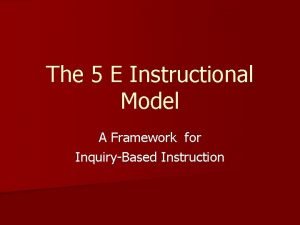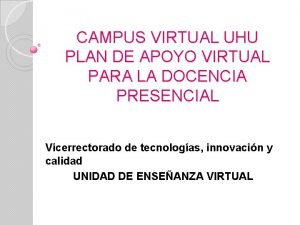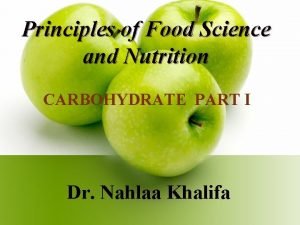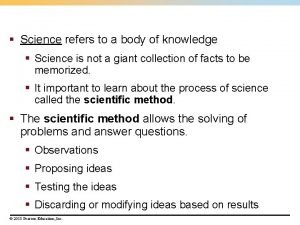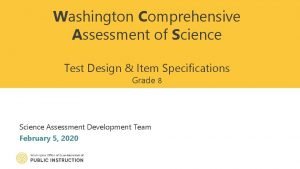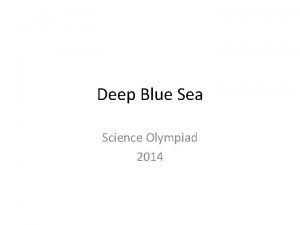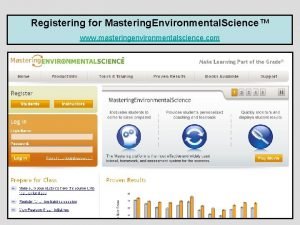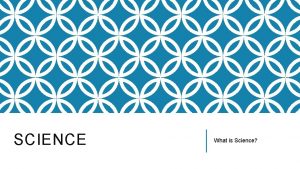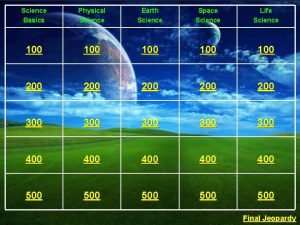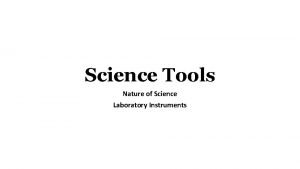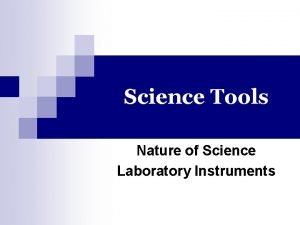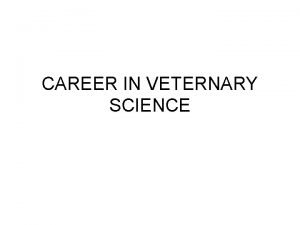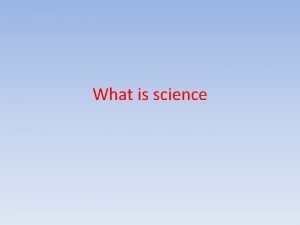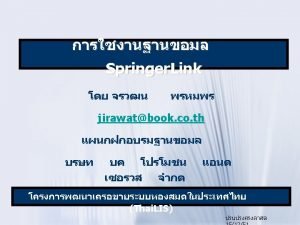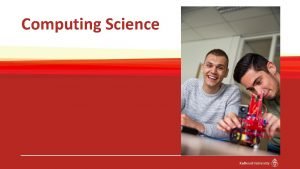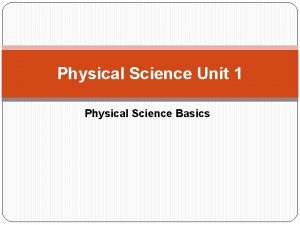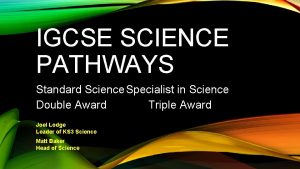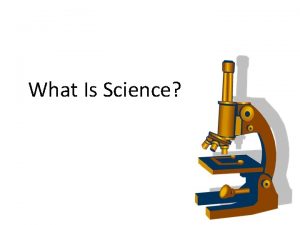What is Science What is Science O Science

















- Slides: 17

What is Science?

What is Science? O Science = Latin “to know” Inquiry is at the heart of science. O Inquiry: search for information and explanation Two main processes: 1. Discovery science 2. Hypothesis-based science

Discovery Science O Describes nature through observation and analysis of data O Data = recorded observations O Qualitative and quantitative O Inductive reasoning: derive generalizations based on specific observations

Hypothesis-Based Science O Hypothesis: makes predictions that can be tested by recording more observations or experiments O AP Biology: “If … , then … because…” O Results can either support or refute the hypothesis O Not “My hypothesis is correct” O Controlled experiments test the “null hypothesis” O No change due to independent variable

Science Practices for AP Bio 1. 2. 3. 4. 5. 6. 7. Use representations and models to communicate and solve problems Use mathematics appropriately Pose scientific questions to extend thinking or guide investigations Plan and implement data collection Analyze data and evaluate evidence Work with scientific explanations and theories Connect and relate knowledge across scales and domains

Introduction to Biology Chapter 1

Biology is the study of LIFE!

Big Ideas in AP Biology Big Idea 1: The process of evolution drives the diversity and unity of life.

Big Ideas in AP Biology Big Idea 2: Biological systems utilize free energy and molecular building blocks to grow, to reproduce and to maintain dynamic homeostasis.

Big Ideas in AP Biology Big Idea 3: Living systems store, retrieve, transmit and respond to information essential to life processes.

Big Ideas in AP Biology Big Idea 4: Biological systems interact, and these systems and their interactions possess complex properties.

Journal Assignment 1 In your journal, identify the most important “Big Idea. ” Justify your answer. Big Idea 1: The process of evolution drives the diversity and unity of life. Big Idea 2: Biological systems utilize free energy and molecular building blocks to grow, to reproduce and to maintain dynamic homeostasis. Big Idea 3: Living systems store, retrieve, transmit and respond to information essential to life processes. Big Idea 4: Biological systems interact, and these systems and their interactions possess complex properties.

Journal Assignment #2 O List the following terms in order of “strength” starting with weakest. Justify your answer. O facts O Hypothesis O Law O Theory

Fact O In science, an observation that has been repeatedly confirmed and for all practical purposes is accepted as “true. ” Truth in science, however, is never final and what is accepted as a fact today may be modified or even discarded tomorrow. Source: http: //dels. nas. edu/resources/static-assets/materials-based-onreports/reports-in-brief/role_of_theory_final. pdf

Hypothesis O A tentative statement about the natural world leading to deductions that can be tested. If the deductions are verified, the hypothesis is provisionally corroborated. If the deductions are incorrect, the original hypothesis is proved false and must be abandoned or modified. Hypotheses can be used to build more complex inferences and explanations. Source: http: //dels. nas. edu/resources/static-assets/materials-based-onreports/reports-in-brief/role_of_theory_final. pdf

Law O A descriptive generalization about how some aspect of the natural world behaves under stated circumstances. Source: http: //dels. nas. edu/resources/static-assets/materials-based-onreports/reports-in-brief/role_of_theory_final. pdf

Theory O In science, a well-substantiated explanation of some aspect of the natural world that can incorporate facts, laws, inferences, and tested hypotheses. Source: http: //dels. nas. edu/resources/static-assets/materials-based-onreports/reports-in-brief/role_of_theory_final. pdf
 Mathematics ____ my favorite subject.
Mathematics ____ my favorite subject. Applied science vs pure science
Applied science vs pure science Julie lundquist
Julie lundquist Natural vs social science
Natural vs social science Rapid change
Rapid change Soft science definition
Soft science definition Mind map main branches of science
Mind map main branches of science Think central science fusion
Think central science fusion Natural and physical science
Natural and physical science Tragedy of the commons
Tragedy of the commons Observing definition science
Observing definition science What are forces?
What are forces? Aula virtual uhu
Aula virtual uhu Principles of carbohydrates
Principles of carbohydrates Science refers to
Science refers to Wa.portal.cambiumast
Wa.portal.cambiumast Deep blue sea science olympiad
Deep blue sea science olympiad Mastering environmental science
Mastering environmental science










